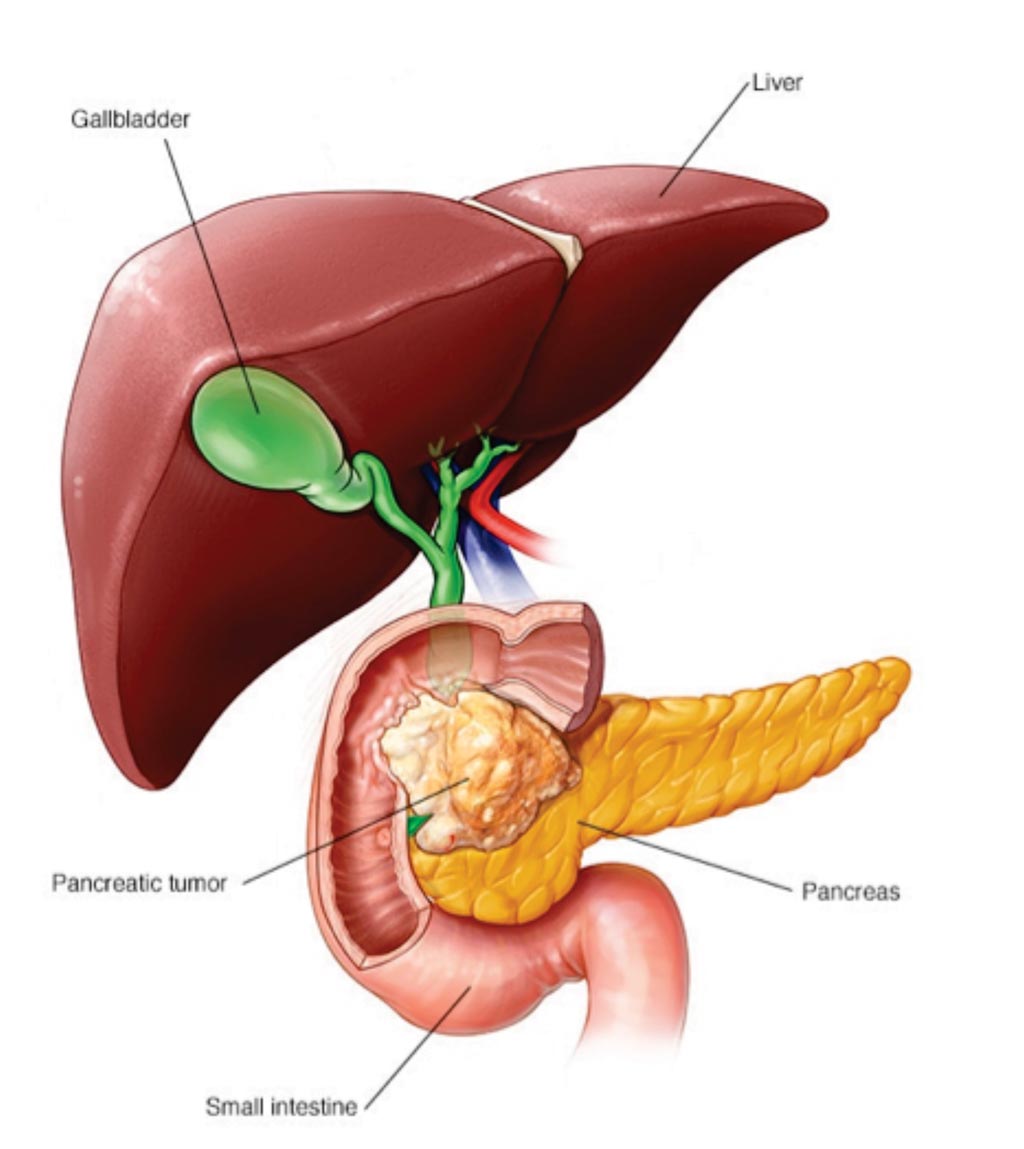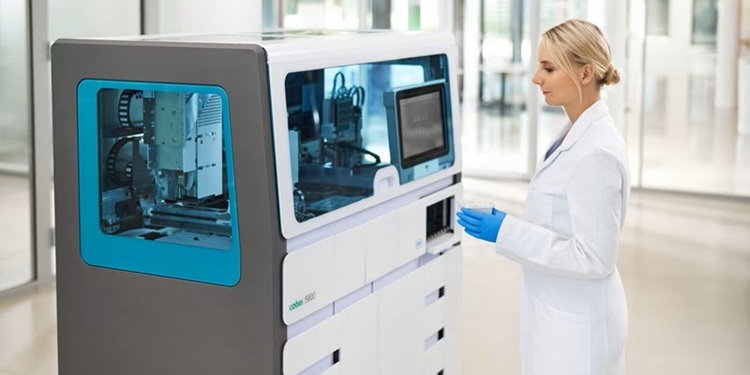Method Identifies Cancer in Early Onset Diabetics
|
By LabMedica International staff writers Posted on 04 Jul 2018 |

Image: Patients diagnosed with pancreatic cancer can develop elevated blood sugar levels up to three years before their cancer diagnosis (Photo courtesy of Mayo Clinic).
It is unclear how long pancreatic ductal adenocarcinomas (PDACs) are present before diagnosis. Patients with PDAC usually develop hyperglycemia and diabetes before the tumor is identified.
It has been suggested that if early invasive PDACs are associated with hyperglycemia, the duration of hyperglycemia should associate with the time that they have had the tumor. Of subjects with new-onset diabetes, based on glycemia, over the age of 50 years, approximately 1% are diagnosed with pancreatic cancer within three years.
Scientists at the Mayo Clinic (Rochester, MN, USA) and their colleagues carried out a study recently exploring methods to diagnose cancer in patients with early onset diabetes. In the first study, they plotted blood sugars levels of patients with pancreatic cancer going back five years prior to diagnosis. They also plotted the blood sugars of a control group of patients who were age and gender matched to the patients with pancreatic cancer. They analyzed temporal fasting blood glucose (FBG) profiles collected for 60 months before patients received a PDAC diagnosis (index date) (cohort A = 219)), FBG profiles of patients with resected PDAC (n=526) stratified by tumor volume and grade (cohort B =526), and temporal FBG profiles of patients with resected PDACs from whom long-term FBG data were available for 103. In another group of patients and controls, they plotted blood sugars of nearly 600 patients with pancreatic cancer just prior to surgical removal of the cancer.
In cohort A, the mean FBG did not differ significantly between cases and controls 36 months before the index date. Hyperglycemia was first noted 30–36 months before PDAC diagnosis in all cases, those with or without diabetes at baseline and those with or without resection at diagnosis. FBG level increased until diagnosis of PDAC. In cohort B, the mean FBG did not differ significantly in controls versus cases with PDACs below 1.0 cc. The smallest tumor volume associated with hyperglycemia was 1.1–2.0 cc; FBG level increased with tumor volume. FBG varied with tumor grade: well- or moderately differentiated tumors (5.8 cc) produced the same FBG levels as smaller, poorly differentiated tumors (1.5 cc). In cohort C, the duration of pre-diagnostic hyperglycemia for cases with large-, medium-, or small-volume PDACs was 24–36, 12–24, and 0–12 months, respectively. PDAC resection resolved hyperglycemia, regardless of tumor location.
Suresh Chari, MD, a gastroenterologist and senior author of the study, said, “Pancreatic cancer is rapidly fatal after its diagnosis, with average survival of six months. It has also been thought that its course prior to diagnosis is also rapid and that early detection is not feasible. But our studies provide hope that pancreatic cancer can indeed be diagnosed at an earlier stage when it is resectable.”
The authors concluded that in a case–control study of patients with PDAC from two databases, they associated FBG level with time to PDAC diagnosis and tumor volume and grade. Patients are hyperglycemic for a mean period of 30–36 months before PDAC diagnosis; this information might be incorporated in strategies for early detection. The study was originally published online on April 30, 2018, in the journal Gastroenterology.
Related Links:
Mayo Clinic
It has been suggested that if early invasive PDACs are associated with hyperglycemia, the duration of hyperglycemia should associate with the time that they have had the tumor. Of subjects with new-onset diabetes, based on glycemia, over the age of 50 years, approximately 1% are diagnosed with pancreatic cancer within three years.
Scientists at the Mayo Clinic (Rochester, MN, USA) and their colleagues carried out a study recently exploring methods to diagnose cancer in patients with early onset diabetes. In the first study, they plotted blood sugars levels of patients with pancreatic cancer going back five years prior to diagnosis. They also plotted the blood sugars of a control group of patients who were age and gender matched to the patients with pancreatic cancer. They analyzed temporal fasting blood glucose (FBG) profiles collected for 60 months before patients received a PDAC diagnosis (index date) (cohort A = 219)), FBG profiles of patients with resected PDAC (n=526) stratified by tumor volume and grade (cohort B =526), and temporal FBG profiles of patients with resected PDACs from whom long-term FBG data were available for 103. In another group of patients and controls, they plotted blood sugars of nearly 600 patients with pancreatic cancer just prior to surgical removal of the cancer.
In cohort A, the mean FBG did not differ significantly between cases and controls 36 months before the index date. Hyperglycemia was first noted 30–36 months before PDAC diagnosis in all cases, those with or without diabetes at baseline and those with or without resection at diagnosis. FBG level increased until diagnosis of PDAC. In cohort B, the mean FBG did not differ significantly in controls versus cases with PDACs below 1.0 cc. The smallest tumor volume associated with hyperglycemia was 1.1–2.0 cc; FBG level increased with tumor volume. FBG varied with tumor grade: well- or moderately differentiated tumors (5.8 cc) produced the same FBG levels as smaller, poorly differentiated tumors (1.5 cc). In cohort C, the duration of pre-diagnostic hyperglycemia for cases with large-, medium-, or small-volume PDACs was 24–36, 12–24, and 0–12 months, respectively. PDAC resection resolved hyperglycemia, regardless of tumor location.
Suresh Chari, MD, a gastroenterologist and senior author of the study, said, “Pancreatic cancer is rapidly fatal after its diagnosis, with average survival of six months. It has also been thought that its course prior to diagnosis is also rapid and that early detection is not feasible. But our studies provide hope that pancreatic cancer can indeed be diagnosed at an earlier stage when it is resectable.”
The authors concluded that in a case–control study of patients with PDAC from two databases, they associated FBG level with time to PDAC diagnosis and tumor volume and grade. Patients are hyperglycemic for a mean period of 30–36 months before PDAC diagnosis; this information might be incorporated in strategies for early detection. The study was originally published online on April 30, 2018, in the journal Gastroenterology.
Related Links:
Mayo Clinic
Latest Pathology News
- AI Tool Outperforms Doctors in Spotting Blood Cell Abnormalities
- AI Tool Rapidly Analyzes Complex Cancer Images for Personalized Treatment
- Diagnostic Technology Performs Rapid Biofluid Analysis Using Single Droplet
- Novel Technology Tracks Hidden Cancer Cells Faster
- AI Tool Improves Breast Cancer Detection
- AI Tool Predicts Treatment Success in Rectal Cancer Patients
- Blood Test and Sputum Analysis Predict Acute COPD Exacerbation
- AI Tool to Transform Skin Cancer Detection with Near-Perfect Accuracy
- Unique Immune Signatures Distinguish Rare Autoimmune Condition from Multiple Sclerosis
- Simple Optical Microscopy Method Reveals Hidden Structures in Remarkable Detail
- Hydrogel-Based Technology Isolates Extracellular Vesicles for Early Disease Diagnosis
- AI Tool Improves Accuracy of Skin Cancer Detection
- Highly Sensitive Imaging Technique Detects Myelin Damage
- 3D Genome Mapping Tool to Improve Diagnosis and Treatment of Genetic Diseases
- New Molecular Analysis Tool to Improve Disease Diagnosis
- Tears Offer Noninvasive Alternative for Diagnosing Neurodegenerative Diseases
Channels
Molecular Diagnostics
view channel
Blood Test to Enable Earlier and Simpler Detection of Liver Fibrosis
Persistent liver damage caused by alcohol misuse or viral infections can trigger liver fibrosis, a condition in which healthy tissue is gradually replaced by collagen fibers. Even after successful treatment... Read more
Genetic Marker to Help Children with T-Cell Leukemia Avoid Unnecessary Chemotherapy
About 400 children in the UK are diagnosed with acute lymphoblastic leukemia (ALL) each year, with roughly 15% presenting with a more aggressive T-ALL subtype. While the standard approach is a four-week... Read more
Four-Gene Blood Test Rules Out Bacterial Lung Infection
Lower respiratory tract infections (LRTIs) are among the most common reasons for antibiotic prescriptions, yet distinguishing bacterial infections from viral ones remains notoriously difficult.... Read more
New PCR Test Improves Diagnostic Accuracy of Bacterial Vaginosis and Candida Vaginitis
Bacterial vaginosis (BV) impacts approximately 25% of women of reproductive age, while up to 75% of women experience candida vaginitis (CV) at least once in their lifetime. Vaginal symptoms are one of... Read moreHematology
view channel
Platelet Activity Blood Test in Middle Age Could Identify Early Alzheimer’s Risk
Early detection of Alzheimer’s disease remains one of the biggest unmet needs in neurology, particularly because the biological changes underlying the disorder begin decades before memory symptoms appear.... Read more
Microvesicles Measurement Could Detect Vascular Injury in Sickle Cell Disease Patients
Assessing disease severity in sickle cell disease (SCD) remains challenging, especially when trying to predict hemolysis, vascular injury, and risk of complications such as vaso-occlusive crises.... Read more
ADLM’s New Coagulation Testing Guidance to Improve Care for Patients on Blood Thinners
Direct oral anticoagulants (DOACs) are one of the most common types of blood thinners. Patients take them to prevent a host of complications that could arise from blood clotting, including stroke, deep... Read moreImmunology
view channel
New Test Distinguishes Vaccine-Induced False Positives from Active HIV Infection
Since HIV was identified in 1983, more than 91 million people have contracted the virus, and over 44 million have died from related causes. Today, nearly 40 million individuals worldwide live with HIV-1,... Read more
Gene Signature Test Predicts Response to Key Breast Cancer Treatment
DK4/6 inhibitors paired with hormone therapy have become a cornerstone treatment for advanced HR+/HER2– breast cancer, slowing tumor growth by blocking key proteins that drive cell division.... Read more
Chip Captures Cancer Cells from Blood to Help Select Right Breast Cancer Treatment
Ductal carcinoma in situ (DCIS) accounts for about a quarter of all breast cancer cases and generally carries a good prognosis. This non-invasive form of the disease may or may not become life-threatening.... Read moreMicrobiology
view channel
Rapid Diagnostic Test Matches Gold Standard for Sepsis Detection
Sepsis kills 11 million people worldwide every year and generates massive healthcare costs. In the USA and Europe alone, sepsis accounts for USD 100 billion in annual hospitalization expenses.... Read moreRapid POC Tuberculosis Test Provides Results Within 15 Minutes
Tuberculosis remains one of the world’s deadliest infectious diseases, and reducing new cases depends on identifying individuals with latent infection before it progresses. Current diagnostic tools often... Read more
Rapid Assay Identifies Bloodstream Infection Pathogens Directly from Patient Samples
Bloodstream infections in sepsis progress quickly and demand rapid, precise diagnosis. Current blood-culture methods often take one to five days to identify the pathogen, leaving clinicians to treat blindly... Read morePathology
view channelAI Tool Outperforms Doctors in Spotting Blood Cell Abnormalities
Diagnosing blood disorders depends on recognizing subtle abnormalities in cell size, shape, and structure, yet this process is slow, subjective, and requires years of expert training. Even specialists... Read more
AI Tool Rapidly Analyzes Complex Cancer Images for Personalized Treatment
Complex digital biopsy images that typically take an expert pathologist up to 20 minutes to assess can now be analyzed in about one minute using a new artificial intelligence (AI) tool. The technology... Read moreTechnology
view channel
Artificial Intelligence Model Could Accelerate Rare Disease Diagnosis
Identifying which genetic variants actually cause disease remains one of the biggest challenges in genomic medicine. Each person carries tens of thousands of DNA changes, yet only a few meaningfully alter... Read more
AI Saliva Sensor Enables Early Detection of Head and Neck Cancer
Early detection of head and neck cancer remains difficult because the disease produces few or no symptoms in its earliest stages, and lesions often lie deep within the head or neck, where biopsy or endoscopy... Read moreIndustry
view channel
Abbott Acquires Cancer-Screening Company Exact Sciences
Abbott (Abbott Park, IL, USA) has entered into a definitive agreement to acquire Exact Sciences (Madison, WI, USA), enabling it to enter and lead in fast-growing cancer diagnostics segments.... Read more




















